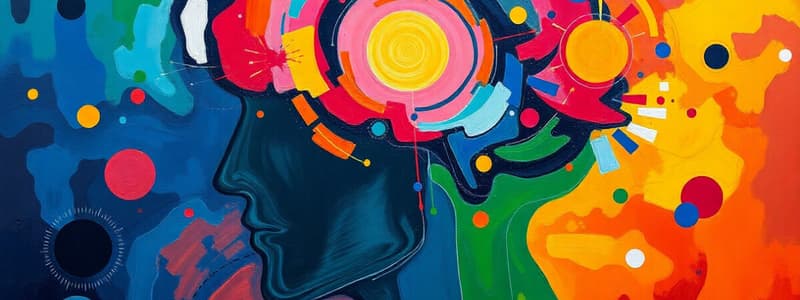Podcast
Questions and Answers
What is the condition characterized by a failure to notice stimuli on the side opposite a hemispheric lesion?
What is the condition characterized by a failure to notice stimuli on the side opposite a hemispheric lesion?
- Balint’s syndrome
- Blindsight
- Unilateral visual neglect (correct)
- Extinction
In unilateral visual neglect, what does the term 'extinction' refer to?
In unilateral visual neglect, what does the term 'extinction' refer to?
- Failure to disengage attention from the target in the good field (correct)
- Loss of residual visual capability
- The complete loss of visual perception
- The inability to shift visual attention to new locations
What is the primary reason blindsight patients can detect visual stimuli despite cortical damage?
What is the primary reason blindsight patients can detect visual stimuli despite cortical damage?
- Enhanced sensitivity to stimuli in the affected area
- Increased reliance on conscious processing
- Compensation through neural plasticity
- Functional subcortical visual pathways (correct)
Which neurological disorder involves a loss of the ability to voluntarily shift visual attention due to bilateral damage?
Which neurological disorder involves a loss of the ability to voluntarily shift visual attention due to bilateral damage?
What does the paradox of unilateral visual neglect imply about patients' awareness of their visual environment?
What does the paradox of unilateral visual neglect imply about patients' awareness of their visual environment?
What did the findings from studies involving monkeys with removed visual cortices suggest about visual processing areas?
What did the findings from studies involving monkeys with removed visual cortices suggest about visual processing areas?
When babies with contralesional blindness were presented with a single target, what was observed?
When babies with contralesional blindness were presented with a single target, what was observed?
Which aspect of unilateral visual neglect allows patients to sometimes report objects in their field of vision?
Which aspect of unilateral visual neglect allows patients to sometimes report objects in their field of vision?
What does the attenuation model propose about information processing?
What does the attenuation model propose about information processing?
Which selective attention model suggests that selection occurs late in the processing stream?
Which selective attention model suggests that selection occurs late in the processing stream?
How does the load model explain the timing of early and late selection?
How does the load model explain the timing of early and late selection?
What is one key feature of the early filter model?
What is one key feature of the early filter model?
What phenomenon does unilateral visual neglect primarily illustrate?
What phenomenon does unilateral visual neglect primarily illustrate?
Blindsight refers to which of the following abilities?
Blindsight refers to which of the following abilities?
What best describes the central idea of the information bottleneck?
What best describes the central idea of the information bottleneck?
Which statement best defines how selective attention works?
Which statement best defines how selective attention works?
What does the study of choice blindness suggest about decision making?
What does the study of choice blindness suggest about decision making?
Which property of consciousness is demonstrated by individuals failing to notice a significant change in their environment?
Which property of consciousness is demonstrated by individuals failing to notice a significant change in their environment?
What is meant by intentionality of consciousness?
What is meant by intentionality of consciousness?
How does change blindness impact our perception?
How does change blindness impact our perception?
What phenomenon occurs when individuals report a preference for a photo they did not consciously choose?
What phenomenon occurs when individuals report a preference for a photo they did not consciously choose?
What does the dichotic listening task illustrate about selective attention?
What does the dichotic listening task illustrate about selective attention?
Which statement reflects the transience of consciousness?
Which statement reflects the transience of consciousness?
How does the brain activity before a conscious decision challenge the concept of free will?
How does the brain activity before a conscious decision challenge the concept of free will?
What is the impact of unity of consciousness in multitasking scenarios?
What is the impact of unity of consciousness in multitasking scenarios?
What role does unconscious influence play in decision making according to the studies mentioned?
What role does unconscious influence play in decision making according to the studies mentioned?
Flashcards
Posner cueing task
Posner cueing task
A study that analyzes how attention is guided by internal processes or external cues.
Homunculus problem
Homunculus problem
The issue of multiple processes competing to control attention, with no single locus for control.
Unilateral visual neglect
Unilateral visual neglect
A condition where patients ignore stimuli on one side of their visual field due to hemispheric brain lesions.
Extinction in neglect
Extinction in neglect
Signup and view all the flashcards
Balint’s syndrome
Balint’s syndrome
Signup and view all the flashcards
Blindsight
Blindsight
Signup and view all the flashcards
Visual processing areas
Visual processing areas
Signup and view all the flashcards
Attention shift requirement
Attention shift requirement
Signup and view all the flashcards
Selective attention
Selective attention
Signup and view all the flashcards
Information bottleneck
Information bottleneck
Signup and view all the flashcards
Early filter model
Early filter model
Signup and view all the flashcards
Attenuation model
Attenuation model
Signup and view all the flashcards
Response selection model
Response selection model
Signup and view all the flashcards
Load model
Load model
Signup and view all the flashcards
Dichotic listening task
Dichotic listening task
Signup and view all the flashcards
GSR study
GSR study
Signup and view all the flashcards
Brain activity before action
Brain activity before action
Signup and view all the flashcards
Choice blindness
Choice blindness
Signup and view all the flashcards
Intentionality of consciousness
Intentionality of consciousness
Signup and view all the flashcards
Change blindness
Change blindness
Signup and view all the flashcards
Unity of consciousness
Unity of consciousness
Signup and view all the flashcards
Selectivity of consciousness
Selectivity of consciousness
Signup and view all the flashcards
Dichotic listening
Dichotic listening
Signup and view all the flashcards
Unconscious influence
Unconscious influence
Signup and view all the flashcards
Count gorilla study
Count gorilla study
Signup and view all the flashcards
Transience of consciousness
Transience of consciousness
Signup and view all the flashcards
Study Notes
Consciousness
-
Cartesian Theatre: A mental screen where things appear presented to the mind's eye. Impossible to share experiences with others.
-
Hard Problem of Consciousness: Difficulty explaining subjective experience.
-
Phenomenology: How things seem to a conscious person, in terms of quality of experience. Three mysteries include the homunculus problem, problem of other minds, and mind-body problem.
Homunculus Problem
-
Difficulty explaining consciousness by suggesting another internal self to do the experiencing.
-
Essentially a mini version of yourself inside your head making decisions for you. This process would continue indefinitely.
Free Will
-
The common assumption individuals are in control of their decisions.
-
The idea of free will may be an illusion affected by reinforcements and punishments.
-
Science may undermine personal choice. Accepting that free will isn't a personal choice is conceptually challenging.
Problem of Other Minds
-
Difficulty in perceiving the consciousness of others.
-
The subjective experience of the world around us causes a barrier to understanding others' consciousness.
Qualia
-
Subjective experiences of our mental life.
-
Qualia cannot be directly accessed by others; hence, impossible to understand another person's experience.
-
Impossible to understand the same experiences.
-
Philosopher's zombie - hypothetical nonconscious being. Their actions are like ours, but inside, they lack an experience.
Materialism
-
Philosophical position: Mental states are a product of physical systems.
-
Consciousness can be explained by a characteristic of the brain.
Anthropomorphism
- Attributing human qualities to non-human things, for example appreciating what a puppy feels.
Mind-Body Problem
-
The issue of how the mind relates to the brain and body.
-
The process by which the mind and body affect each other is not clear.
Studies:
-
Online surveys compared minds between different targets with different capacities of experience and agency, eg babies, chimps, robots, humans, etc.
-
Brain activity measured to determine conscious decisions to move their hands and choice, measured in milliseconds.
-
Studies on choice blindness, adults choosing between photos, showed unconscious choices leading to explanations for the choice.
-
Studies on unconscious influence on decision-making, such as choosing beverages.
-
Participants counting basketball passes and noticing events in their awareness, like a gorilla passing through.
-
Dichotic listening tasks, selectively focusing on one message, while filtering another message.
-
Cocktail party phenomenon, selecting a message of special interest among other conversations.
-
Participants asked not to think of a white bear for a period of time, noticed that idea more frequently.
-
Participants reported their thoughts when participating in an experience sampling technique.
Properties of Consciousness
-
Intentionality: Being directed towards an object.
-
Unity: Resisting division.
-
Selectivity: Focusing on certain things.
-
Transience: Changing over time.
Change Blindness
-
People unaware of significant events happening in full view.
-
The lack of attention leads to these happenings being undetected.
Minimal Consciousness
- A low level of awareness.
Full Consciousness
- Awareness of the experience and the ability to report that.
Self Consciousness
-
Focusing on the self as an object.
-
Usually when introspective, regarding thoughts, feelings or personal qualities.
Studies:
-
Candy and mirror experiment to see if children's greed is decreased by presence of a mirror.
-
Students less likely to cheat when a mirror is present.
Daydreaming
- A state of consciousness with seemingly purposeless thoughts and flow.
Mental Control
- Attempts to change conscious states of mind, like thought suppression.
Rebound Effect
- The tendency of a suppressed thought to reappear more frequently.
Dynamic Unconscious
- Active system of hidden memories, instincts and desires.
Repression
- A mental process that keeps thoughts inaccessible by removing them from consciousness.
Cognitive Unconscious
- Mental processes not directly experienced, but which affect thoughts, choices, emotions, and behavior.
Subliminal Perception
-
Thoughts or behavior changed by stimuli a person doesn't consciously notice.
-
Occurring too briefly and weakly in experience for awareness.
Selective Attention
- Focusing on a range of events, such as selecting one thought through a stream of thoughts, exemplified in a Gorilla-suit-man task.
Information Bottleneck
-
Information processing capacity is limited, only important information is processed.
-
Early filter model, selecting important information early.
-
Attenuation model, suppressing information.
Response Selection Model
- Selecting occurs late in the processing stream before responding.
Load Model
-
Attention selection depends on task difficulty.
-
Easy tasks use early selection. Difficult tasks use late selection.
Shifting Attention
- Attention guided by voluntary and involuntary processes (internal or external stimuli).
Unilateral Visual Neglect
- Inattention to stimuli on the opposite side of a brain-lesion's location.
Extinction
- Failure to pay attention to a target in the non-affected vision.
Balint's Syndrome
- Attentional disorder, problems in visually bringing important parts of the vision into the centre of awareness.
Blindsight
-
Residual visual ability after disabling cortical vision areas.
-
Unconscious visual processing areas are present.
Studies:
-
Babies in contralesional field with single and multiple targets. This shows the conscious need to shift attention to be aware of things.
-
Humans and monkeys trained to look at targets, regardless of lesion-affected vision.
Studying That Suits You
Use AI to generate personalized quizzes and flashcards to suit your learning preferences.




